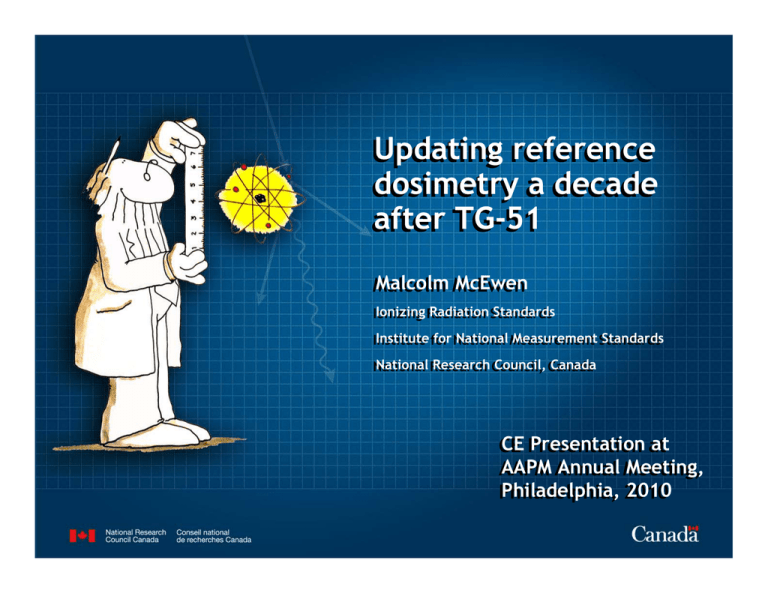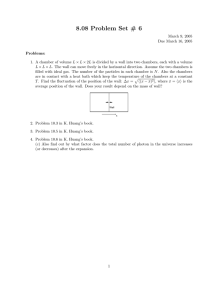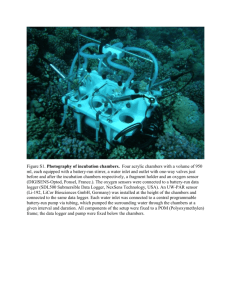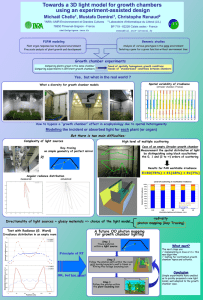Updating reference dosimetry a decade after TG-51 Malcolm McEwen
advertisement

Updating reference dosimetry a decade after TG-51 Malcolm McEwen McEwen Malcolm Ionizing Radiation Radiation Standards Standards Ionizing Institute for for National National Measurement Measurement Standards Standards Institute National Research Research Council, Council, Canada Canada National CE Presentation Presentation at at CE AAPM Annual Annual Meeting, Meeting, AAPM Philadelphia, 2010 2010 Philadelphia, Background 1. Reference dosimetry for linac beams based on a 60Co calibration. 2. Simple step-by-step procedure. 3. Covers photon and electron beams. 4. Very successful, extensively tested, no significant problems reported. 2 Background BUT 1. Almost 10 years have passed since TG-51 came out. 2. A large number of ionization chambers have come onto the market since ‘99. 3. Data from the US ADCLs indicates that users are obtaining 60Co absorbed dose calibration coefficients for these chambers. i. To use such chambers correctly in linac beams with TG-51 requires more than just ‘following the recipe.’ ii. Not all may be suitable for reference dose measurements. 4. A number of papers suggest that the electron dosimetry section of the protocol requires updating to take account of revised correction factors. 5. Time for something to be done? AAPM Working Group on TG-51 ¾ Formed November 2006 ¾ Charge includes, “The WG will thus present a review of measured and calculated kQ data as well as a clarification document for TG-51 that contains tables of kQ for chambers currently not listed in the protocol.” ¾ Comprises: Malcolm McEwen (Chair, National Research Council Canada), David Rogers (Carleton University), Jan Seuntjens (McGill University), Larry DeWerd (UWisc ADCL), Geoff Ibbott (RPC), Steve Seltzer (NIST), Hugo Palmans (NPL, UK) ¾ Due to report in 2011 TG-51 reminder ¾ TG-51 is a procedure to give you a measurement of the absorbed dose to water at a point in a water phantom ¾ It’s based on measurements with a calibrated ion chamber: Dw,Q = N 60 Co D,w kQ M ion ¾ ND,w is obtained from an ADCL or primary standards laboratory (e.g., in Canada) ¾ kQ is the factor that converts from the calibration beam (60Co) to the uses linac beam, defined by beam quality Q ¾ Q can represent a photon or electron beam Update – the same approach for photons & electrons? ¾ Photons – requirements are: i. ii. iii. iv. kQ factors for an updated list of chambers Review of calculated kQ factors Uncertainty analysis Implementation guidance notes (clarification) Most pressing is the need for new kQ factors with so many new chambers on the market Update – the same approach for photons & electrons? ¾ Electrons – requirements are: i. Improved values for kecal (conversion from 60Co to high-energy electron beam) ii. Implications of non-zero perturbation correction factors for parallel-plate chambers (revised k’R50 values) iii. Recommendation on calibration in 60Co versus cross-calibration iv. Cylindrical or parallel-plate chamber? Note that two of the points require correction to the data in TG-51 Conclusion? Split the review into 2 parts: 1. Photons – update of TG-51 (new document adds to original, no significant revision, straightforward) 2. Electrons – revision of TG-51 (new document replaces original, not straightforward) Part 1 - photon addendum The report will cover the following: A. kQ factors for new chambers B. Comparison of measured and calculated kQ factors C. Uncertainty analysis for implementation of TG-51 D. Recommendations for implementation TG-51 photons – what stays? ¾ TG-51 remains based on a calibration coefficient obtained in Co-60. 9 MV standards and calibration services are already available in certain countries but widespread dissemination in the US is not realistic at the present time. ¾ %dd(10)x remains the beam quality specifier. 9 Research has shown that TPR20,10 and %dd(10)x are both valid in heavily filtered beams but %dd(10)x provides greater consistency in assignment of kQ factors across varied MV beams (low-Z targets, flattening free linacs, etc). ¾ Thimble chambers remain the recommended chamber type for photon beams. 9 Still question marks over parallel-plate chambers for absolute measurements in MV photon beams. Ionization chambers ¾ What are we talking about? ¾ 2 main types – I. Cylindrical (thimble) chambers II. Parallel-plate chambers ¾ Thimble chambers recommended for photon beam dosimetry ¾ 3 sub-types (NOTE: WGTG51 definitions) – i. 0.6 cm3 reference chambers (e.g., NE2571, PR-06C) ii. 0.125 cm3 scanning chambers (e.g., PTW31010, IBA CC13) iii. 0.02 cm3 micro chambers (e.g., Exradin A16, PinpointTM) Examples 3PTW31010 1010 0.125 cm3 Scanning chamber IBA CC01 0.01 cm3 Micro chamber CC01 Exradin A12 A12 NE2577 NE2577 0.6 cm3 ‘Farmer’ chamber 0.25 cm3 ‘Short Farmer’ A. Calculation of kQ factors Dw,Q = N 60 Co D,w kQ M ion ¾ To be consistent with TG-51 the same analytical approach has been taken: ( kQ = (L / ρ ) water air Pcel Prepl Pwall ) Q Co − 60 ¾ values calculated for chambers from all three major manufacturers – PTW, Standard Imaging, IBA ¾ Same program used as for TG-51 ¾ All metal electrodes treated as 1 mm diameter aluminum Results - calculations Stopping power ratio is largest contributor to the overall kQ Pwall is largest perturbation correction and can be significant Results - calculations 1.010 1.010 CC01 1.000 PTW31010 1.000 CC04 Exradin A18 CC13 0.990 Sc-Well CC13 0.990 FC65G FC65P 0.980 kQ kQ 0.980 0.970 0.970 0.960 0.960 IBA chambers Scanning chambers 0.950 0.950 0.940 0.940 50 60 70 80 90 100 50 60 70 dd(10)x There are significant differences between: a) Chambers from a single manufacturer b) Chambers of a similar type from different manufacturers 80 dd(10) x 90 100 Limitations of calculations ( kQ = (L / ρ ) water air Pcel Prepl Pwall ) Q Co − 60 ¾ Perturbation correction factors do not take entire geometry of chamber into account. There is no dependence in the calculation on the length of the cavity. ¾ Two chambers with the same central electrode, diameter and wall thickness will have identical kQ factors irrespective of cavity length: Exradin A12 and A12S IBA CC13 and CC25 PTW31010 and PTW31013 NE2571 and NE2577 ¾ This has not been tested in any great detail in the literature. B. Experimental kQ factors – Development of primary standards and calibration services The primary standard for absorbed dose in linac photon beams worldwide is the Calorimeter R2 Rth+wire Vout R3 R4 bridge circuit thermistor Dm = cm ΔT Vm 3.0 10-6 2.5 10-6 bridge output signal calorimeter phantom Vout(V) 2.0 10-6 1.5 10-6 1.0 10-6 isolation 5.0 10-7 0.0 10-7 Calorimeters can look very different but all have these basic components -200 -100 0 Time (s) 100 200 Very simple relation between the radiation‐ induced temperature rise and the absorbed dose – just need the specific heat capacity B. Experimental kQ factors – Development of primary standards and calibration services A few laboratories worldwide are working on MV standards Primary standards for MV photons: • • • • • • • • • • NIST (US) NRCC (Canada) NPL (UK) PTB (Germany) LNHB (France) ENEA (Italy) NMi (Netherlands) METAS (Switzerland) ARPANSA (Australia) VNIIFTRI (Russian Fed.) Calibration services for MV photons: • • • • • NRCC NPL LNHB METAS VNIIFTRI Chambers usually calibrated: • NE2611, NE2571 • PTW30001, PTW30013 • Exradin A12 • Capintec PR-06C Almost exclusively Farmer-type B. kQ factors – comparison of measurement with calculation NE2571 Reference: Report 18 of the Netherlands Commission on Radiation Dosimetry kQ factors – multiple chambers Compare experimental values obtained at NRC Canada with calculated kQ factors – 6, 10 & 25 MV photon beams (McEwen, Med. Phys., 2010) Mean and Max evaluated for single chambers for 3 photon beams PTW Mean diff Max diff Exradin Mean diff Max diff IBA Mean diff Max diff PTW30010 0.0% 0.0% A19 0.1% 0.3% FC-65G 0.2% 0.4% PTW30012 0.2% 0.3% A12 0.0% 0.3% FC-65P 0.0% 0.1% PTW30013 0.3% 0.4% A12S 0.1% 0.3% FC-23C 0.2% 0.3% PTW31010 0.5% 0.8% A18 0.0% 0.2% CC25 0.1% 0.2% PTW31013 0.1% 0.4% A1SL 0.1% 0.3% CC13 0.2% 0.3% PTW31014 0.0% 0.1% A14 0.2% 0.4% CC08 0.3% 0.4% PTW31016 0.0% 0.3% A16 0.7% 1.3% CC04 0.1% 0.2% CC01 0.7% 1.1% ¾ Experimental data all from a single laboratory ¾ A difference greater than 0.5% is statistically significant kQ factors – multiple chambers For TG-51 what we really want to know is whether the calculated factors are applicable to actual chambers PTW Mean diff Max diff Exradin Mean diff Max diff IBA Mean diff Max diff PTW30010 0.0% 0.0% A19 0.1% 0.3% FC-65G 0.2% 0.4% PTW30012 0.2% 0.3% A12 0.0% 0.3% FC-65P 0.0% 0.1% PTW30013 0.3% 0.4% A12S 0.1% 0.3% FC-23C 0.2% 0.3% PTW31010 0.5% 0.8% A18 0.0% 0.2% CC25 0.1% 0.2% PTW31013 0.1% 0.4% A1SL 0.1% 0.3% CC13 0.2% 0.3% PTW31014 0.0% 0.1% A14 0.2% 0.4% CC08 0.3% 0.4% PTW31016 0.0% 0.3% A16 0.7% 1.3% CC04 0.1% 0.2% CC01 0.7% 1.1% Note ‐ no apparent dependence on cavity length kQ factors – what about Monte Carlo? Isn’t MC the way to go? ¾ ¾ ¾ Chambers today can be modelled in exquisite detail Codes yield high-precision data, accuracy tested in multiple benchmarking investigations Standard approximations can be easily tested Very useful but remember - for photon beams the starting principle was that we are not replacing TG-51 C. Uncertainties 1. TG-51 made the deliberate decision not to include uncertainties. 2. Other protocols have included uncertainty budgets and/or detailed reviews of uncertainty components. 3. It’s time to give some guidance on: i. How to develop an uncertainty budget ii. Typical values for individual components. 4. The ISO GUM is the starting point 5. Improved, uniform uncertainty reporting in radiotherapy dosimetry will lead to improved QA of treatment delivery and allow better comparisons between cancer centres. Uncertainties – what’s the GUM? 1. ISO Guide to the Expression of Uncertainty in Measurement 2. Short answer – procedure to estimate the total uncertainty in your measurement 3. Long answer – more than you ever wanted to know about probability distributions, uncertainty budgets, degrees of freedom, coverage factors and how to turn a guess into an estimate. 4. BUT, the best way to ensure that you take all uncertainty components into account properly. 9 NIST has produced an explanatory document (a guide to the Guide) - NIST Technical Note 1297 9 BUT, a document specific to external beam radiation dosimetry is also necessary (TG-138 deals with brachytherapy) C. Uncertainty budget Component of Uncertainty Measurement SSD setting ¾ ¾ ¾ Discussion of Type A and B uncertainties (distinct from ‘random’ and ‘systematic’) Uncertainty budget broken down into: Measurement Calibration data Influence quantities Typical values discussed but emphasis on individual users constructing site-specific uncertainty budgets for their calibration situations Depth setting Charge measurement PTP correction Calibration data Co-60 ND,w kQ factor Assignment of kQ factor Influence quantities Ppol Pion Pre-irradiation history Note - table is deliberately blank. The important point is to identify the components of uncertainty in the realization of dose. Pleak Calibration coefficient (chamber stability) Linac stability OVERALL Type A Type B D. Recommendations A number of recommendations will be given in the photon update: 1. Specification of a reference chamber 2. Choice of polarizing voltage 3. Solid phantoms 4. Effective point of measurement D.1 Chamber spec Based on objective assessment of chamber performance Measurand Specification Chamber settling Must be less than a 0.5% change in reading from beam-on to stabilization Pleak < 0.1 % of chamber reading Ppol < 0.4 % correction < 0.5 % maximum variation with energy (total range) Pion Correction must be linear with dose per pulse Initial recombination must be < 1.002 at 300 V Correction follows Boag theory for chamber dimensions. Difference in initial recombination correction between opposite polarities <0.1% kQ < 0.5% difference between measured and calculated (TG-51) factors Note - the last point is clearly less objective as it assumes the calculation is correct. Useful, however, in the absence of any other data. D.1 Chamber spec Based on results in the literature we can state that at least the following meet this specification: o NE2571 and NE2611 o PTW30010, PTW30012, PTW30013, PTW31013 o Exradin A12, A12S, A19, A18, A1SL o IBA FC65-G, FC65-P, FC23-C, CC25, CC13 o Capintec PR-06C NOTE – majority are 0.6 cm3 ‘Farmer-type’ chambers 5 scanning chambers, NO microchambers D.2 Polarizing voltage M corr , w = M raw PTP Pion Ppol Pelec ¾ ¾ ¾ ¾ Recombination correction directly affects measurement of absorbed dose Recombination correction well established but not always straightforward 2-voltage technique as set out in TG-51 applicable only to chambers exhibiting ideal behaviour Many examples in literature of anomalous behaviour D.2 Polarizing voltage Non-linearities in a plot of 1/reading vs 1/polarizing voltage indicates nonideal behaviour. References: DeBlois et al (Med. Phys., 2000), McEwen (Med. Phys., 2010) D.2 Polarizing voltage Based on results in the literature we can state the following: ¾ Not all chambers follow standard ‘Boag’ theory ¾ Manufacturers’ statements on voltage limits need verifying (at least for chamber types, if not individual chambers) ¾ Going to a higher polarizing voltage can lead to a larger uncertainty in the measurement ¾ Recombination can be a function of the sign of the charge collected ¾ WG recommends a maximum value of 300 V (lower values may be required for small-volume chambers) D.3 Solid phantoms Advantages: Disadvantages: 1. No water to spill! 2. Easy to move from one linac to another. 3. Robust setup of SSD and chamber position. 4. Improved formulations with ‘reference’ grade material now available 1. Not truly water equivalent for all beams. 2. Not easy to distinguish different formulations. 3. Homogeniety not guaranteed. 4. Characterization in the clinic is time consuming. Conclusion - reference dose-to-water measurements should be based on the dose measured in a water phantom – solid phantoms not recommended for reference dosimetry. D.4 Effective point of measurement ¾ ¾ ¾ Measurement of depthdose curves requires taking account of the effective point of measurement. For thimble chambers TG-51 recommends 0.6rcav upstream from centre. Recent theoretical and experimental investigations have shown that this is not correct. D.4 Effective point of measurement ¾ EPOM varies with chamber design and beam specification – shift is not universal. ¾ No chamber has the TG-51 recommended shift of 0.6rcav ¾ Effect is generally small but easily measurable with modern water phantoms in the build-up region. NOTE - no significant effect on measurement of dose at dref Dose gradient at 10 cm ~ 5% per cm. Max shift in EPOM is ≤ 1 mm Reference: Tessier and Kawrakow (Med. Phys., 2010) Δdose ~ 0.5% (worst case) Part 2 – electron dosimetry ¾ Same basic equation is used for electrons as for photons: Dw,Q = N 60 Co D,w kQ M ion ¾ kQ is split into 3 components: kQ = Pgr kecal k' R 50 ¾ Pgr corrects for gradient effects (thimble chambers only) ¾ kecal converts from Co-60 to a high-energy electron beam ¾ k’R50 gives relative energy dependence in electron beams Part 2 – electron revision 1. DATA - keep formalism from TG-51, dose still based on 60Co but update/replace data that was incorrect in TG-51 or not provided for new types of ion chamber: kQ = Pgr kecal k' R 50 ¾ Pgr - need to re-evaluate in light of new effective point of measurement data for photon beams. ¾ kecal – improved value available in literature for NACP-02 chamber, new values required for new chamber types (Exradin A10, IBA PPC-05, PTW34045). ¾ k’R50 – TG-51 assumes that well-guarded parallel-plate chambers have a unity perturbation correction. Multiple publications now show this is not the case – new data required. Ion-chamber perturbation corrections Monte Carlo investigations All show significant chamber perturbation corrections at dref for low energy beams and a significant variation with depth References: Verhaegen et al (PMB, 2006), Buckley and Rogers (Med. Phys., 2006), Araki (Med. Phys., 2008) Choice of chamber type needs addressing 2. Chamber type – what should be the recommendation regarding ion-chamber types and low energy beams? i) Most commonly used beams are 6 & 9 MeV ii) Some protocols insist on using parallel-plate chambers, TG-51 allows cylindrical down to R50 = 2 cm iii) Objectively, which is better? iv) Requires accurate experimental data comparing different detectors together with experimental values of kecal and k’R50 Measurement of k’R50 1.10 TG-51 k'R50 TRS-398 kQ,Qint Relative energy dependence 1.08 Limited highaccuracy data at present – more required. NPL graphite calorimeter METAS Fricke McGill water calorimeter NRC water calorimeter 1.06 1.04 1.02 1.00 0.98 0 2 4 6 R50 (cm) Reference: McEwen and DuSautoy (Metrologia, 2009) 8 10 12 Conclusion ¾ Changes to TG-51 are coming ¾ Photons – the changes will not be dramatic ¾ Electrons – a (somewhat) revised protocol is required ¾ The basic calibration/reference field for clinical dosimetry will remain 10 cm x 10 cm @ 1 m for some time Thank you 41




